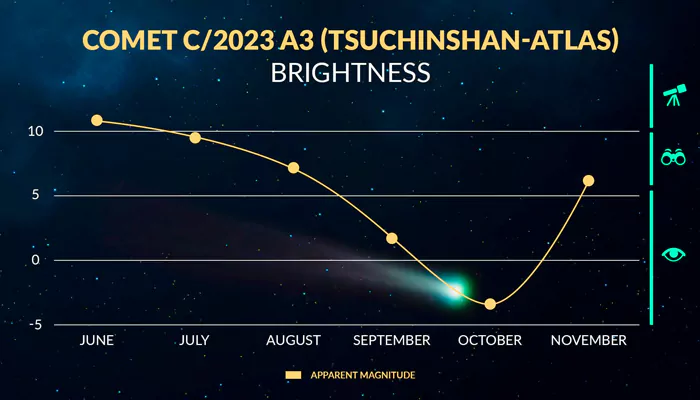Observe Tsuchinshan-ATLAS Without a Telescope: First Time in 80,000 Years
- Soham Halder
- 1 year ago
- 4 minutes read

The time has come to observe the best comet of 2024 visible in the sky!
Since the theory of asteroid impact behind extinction of dinosaurs was confirmed, any approaching celestial body or rare night sky observations become a topic of discussion among science enthusiasts. People have started recording the movement of earth, moon, and other stars since ancient times. Scientists keep an eye on every celestial body to understand the universe in a better way. In modern space science, mathematical modeling, thorough observations, artificial intelligence, and other advanced technologies are also employed. If you are interested in astronomy, then you must explore and learn more about night sky. There is a big news for skygazers as the world is going to witness a once-in-a-80,000 year phenomenon. We are talking about comet Tsuchinshan-ATLAS which will be visible in naked eye throughout the globe in just few days. In this article, we will discuss about this rare occurrence and essential skygazing tips.
Comet C/2023 A3 (Tsuchinshan-ATLAS) is brightening more rapidly than expected! 🌟 Currently at a brightness of magnitude 8.7, it might become one of the most luminous comets visible in the northern hemisphere in nearly three decades this October! 🌠
— Star Walk (@StarWalk) August 2, 2024
On July 28, 2024, Gerald… pic.twitter.com/psxfrBdecU
(Credit - X/@StarWalk)
Celestial Spectacle:
The Comets are simply icy structure made up of dust. The C/2023 A3 or Tsuchinshan-ATLAS will reach its peak brightness phase on Friday, Sept. 27. On that day, the comet will reach perihelion or the closest point to the sun on its 80,000-year-long orbit.
The comet is already visible from Southern hemisphere. People in the Northern Hemisphere will be able to observe this comet in the east-southeast horizon at least 30 minutes before sunrise between Friday, Sept. 27 to Wednesday, Oct. 2. As per recent calculations, skygazers will enjoy the perfect morning views on Sunday, Sept. 29 and Monday, Sept. 30.
From Oct. 9, the comet would be visible at the sunset time. Conservative estimates predicted this comet to be in the list of top 50 brightest objects in the sky during this period. As it will be much brighter than Jupiter, the comet will be observed in naked-eye. The closest passage for this comet with the Earth falls on October 12.
So far Comet Tsuchinshan-ATLAS looks like a fuzzy star to the naked eye looking out the cupola windows. But with a 200mm, f2 lens at 1/8s exposure you can really start to see it. This comet is going to make for some really cool images as it gets closer to the sun. For now a… pic.twitter.com/JstaSLJ4Ui
— Matthew Dominick (@dominickmatthew) September 19, 2024
(Credit - X/@dominickmatthew)
From November, the C/2023 A3 will slowly lose its brightness and move away from the Earth. During end-November to mid-December, the distance between the comet and earth will be around 1.94 AU. The comet will continue to move towards the edge of the Solar System for upcoming 20 years. For another 26,000 years, this will not return nearby to our planet or sun.
Essential Tips:
You need only three things to observe celestial events in naked-eye. These are: luck, clear skies and surrounding darkness. The first and foremost thing is to ensure safety of the surroundings selected for stargazing. Never go alone for stargazing even if you are in your house balcony. Remember, the Comets look like fuzzy structures, much larger than the stars. The distinguishing factor is a long faint tail.

(Credit - X/@MarGomezH)
More about Comets:
We often get excited to observe celestial spectacles including eclipse, comets, asteroids, and movement of stars. Approximately, one comet is visible to the naked eye every year. Many others remain undetected or faint. Some of the examples of visible Comets are 12P/Pons–Brooks (once in 71 years), Halley's Comet (once in 75 years), and so on. Some other periodic Comets are NEOWISE, PanSTARRS, 144P/Kushida, and so on.
You can enjoy the astonishing views of this comet without telescope.



.webp)
.WEBP)
.WEBP)
.webp)
.webp)


.webp)
.webp)
.webp)